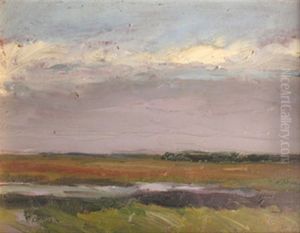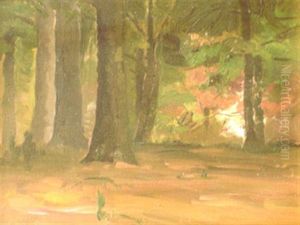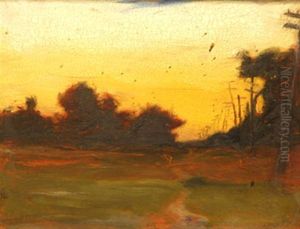Charles Henry Fromuth Paintings
Charles Henry Fromuth was an American artist known for his marine etchings and pastel work, often drawing inspiration from the coastal landscapes of France. Born on December 23, 1861, in Philadelphia, Pennsylvania, Fromuth developed an interest in art at an early age. He began his formal art education at the Pennsylvania Academy of the Fine Arts in Philadelphia, where he studied under Thomas Eakins, one of America's foremost realist painters.
After completing his studies, Fromuth traveled to Europe to further his artistic training, which was a common practice for American artists at the time. He settled in the port city of Concarneau in Brittany, France, which became his adopted home and the primary source of his artistic inspiration for the majority of his career. Concarneau was a well-known artist colony that attracted many painters with its picturesque and vibrant maritime scenes.
Fromuth became particularly fascinated with the effects of light on water and the daily life of fishermen. His work often depicted the harbor, boats, and the sea under varying weather conditions. He was a master of pastels, and his technique captured the shimmering light and atmosphere of the Brittany coast with a unique blend of Impressionism and Realism. At times, his style showed the influence of French Impressionists like Claude Monet, particularly in his sense of color and light.
In addition to pastels, Fromuth was skilled in the art of etching, and his prints contributed to the revival of the etching medium in the late 19th and early 20th centuries. His etchings were praised for their technical precision and evocative portrayal of marine subjects.
Despite living abroad, Fromuth maintained connections with the American art world. He exhibited his work in the United States and Europe, receiving recognition and awards in both continents. Today, his work can be found in the collections of various museums and galleries, reflecting his modest but enduring legacy in the realm of maritime art.
Charles Henry Fromuth continued to live and work in Concarneau until his death on June 28, 1937. His devotion to the coastal town and its seafaring culture left a significant mark on the community and provided a rich body of work that continues to be appreciated for its contribution to marine art and the unique fusion of American and French artistic styles at the turn of the century.





























